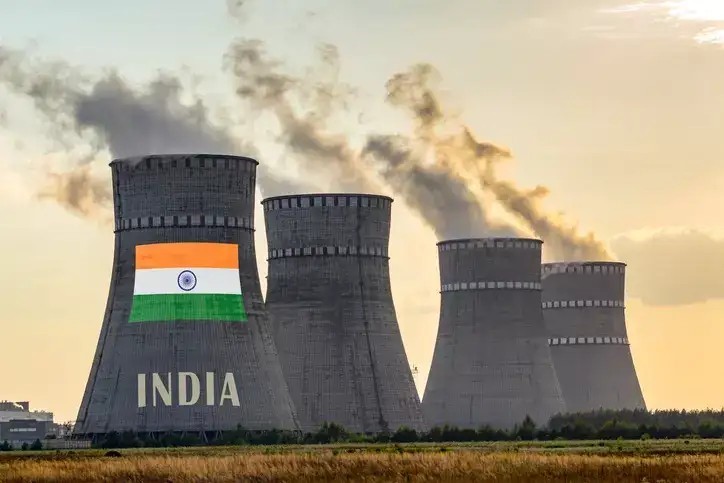India’s Power Demand, Hydrogen Integration and Nuclear Expansion
Syllabus:
GS-1:Mineral & Energy Resources
GS-3:Nuclear Technology
Focus:
India’s rising electricity demand, net-zero commitments, and the push for hydrogen as an industrial fuel have intensified discussions on diversifying clean energy sources. The government’s nuclear expansion plans, combined with policies for green hydrogen and energy storage synergy, are critical for sustainable energy security and industrial decarbonisation.

Net-Zero Economy: The Need for Electrification and Hydrogen:
Electrification as the Backbone of Net-Zero Goals
- Achieving a net-zero emissions economy hinges on widespread electrification of energy end-uses.
- Fossil fuels today are not just used for power but also for producing heat and industrial molecules.
- For example:
- Coal provides carbon to reduce iron ore in steel production.
- Natural gas-derived hydrogen is used for producing ammonia in fertilizers.
- Coal provides carbon to reduce iron ore in steel production.
- In a net-zero scenario, hydrogen must replace fossil fuel molecules in industries like steel, fertilizer, and chemicals.
Hydrogen as a Decarbonisation Tool
- Hydrogen can replace carbon in steelmaking, reducing dependency on coal.
- This transition complements electrification for sectors where direct electrification is difficult.
- Thus, a future low-carbon economy means hydrogen and clean electricity must work together.
| Current Regulatory Landscape of Nuclear Energy in India: Centralized Control: Nuclear energy is governed exclusively by the Atomic Energy Act, 1962, under the central government. Regulatory Body: The Atomic Energy Regulatory Board (AERB) ensures nuclear safety, compliance, and operational standards. Liability Framework: The Civil Liability for Nuclear Damage Act, 2010 caps operator liability at ₹1,500 crore, with the government covering excess damage. Insurance Mechanism: The India Nuclear Insurance Pool (INIP) offers risk coverage for nuclear accidents and liability claims. International Compliance: India follows IAEA safeguards under the Indo-US Civil Nuclear Agreement but remains outside the Non-Proliferation Treaty (NPT), preserving strategic autonomy. |
India’s Expanding Power Demand and Nuclear Ambitions:
India’s Power Demand Forecast
- Experts predict a sharp rise in electricity demand as India advances toward a net-zero economy.
- Renewable energy sources like solar, wind, and hydro alone cannot meet this rising demand.
- Nuclear energy is expected to play a critical role in India’s future energy mix.
Government’s Nuclear Roadmap
- India has set an aspirational target: 100 GW nuclear installed capacity by 2047.
- The Nuclear Power Corporation of India Ltd. (NPCIL) is aggressively expanding nuclear capacity.
Ongoing and Upcoming Nuclear Projects
- Two 700 MW PHWR units operational in Kakrapar, Gujarat.
- Rajasthan has synchronized one new unit to the grid in March 2025, with another underway.
- Two more units are being built in Haryana.
- NPCIL’s fleet expansion plans:
- Announced 10 new reactors in 2017.
In March 2025, declared plans for an additional 10 reactors.
- Altogether: 26 units of 700 MW PHWRs expected when completed.
- Announced 10 new reactors in 2017.
Small Nuclear Reactors: Bharat Small Reactors (BSRs)
- NPCIL is also promoting 220 MW Bharat Small Reactors (BSRs) for captive use.
- BSRs are an advanced evolution of earlier 220 MW PHWRs, fully supported by domestic industry capabilities.
- Indian industries can manufacture all necessary equipment and components, enhancing self-reliance.
Low-Carbon Energy Mix: Nuclear, Solar, Wind & Hydro:
Balancing Intermittent Renewables
- Solar and wind are clean but intermittent, needing backup or storage solutions.
- Nuclear power is ideal for base load supply, offering stability to the grid.
- Currently, coal-fired power plants are flexed to manage renewable fluctuations — lowering emissions but still relying on coal.
Flexing Nuclear Plants: Technical & Economic Barriers
- Flexing nuclear plants is technically complex and economically inefficient.
- High capital costs discourage operating them at part-loads, as the variable costs remain unchanged or only slightly decrease.
- While load-following reactors exist in a few countries, they are not yet cost-competitive or widely scalable.
Hydrogen as an Energy Balancer
- When surplus electricity is available (especially from renewables), it can be used to produce hydrogen via electrolysers.
- This reduces the need for nuclear flexing or curtailing wind and solar power.
- Hydrogen acts as an industrial feedstock, not for power reconversion, ensuring energy efficiency.
Green Hydrogen, Policy Incentives & Low-Carbon Redefinition:
Defining Green Hydrogen
- India classifies hydrogen produced from solar and wind-powered electrolysers as green hydrogen.
- The government is promoting this with incentives and a draft certification scheme.
- Hydrogen qualifies as “green” if its CO2 emissions do not exceed 2 kg CO₂/kg H₂ on average.
Redefining Hydrogen as Low-Carbon
- Hydrogen produced from renewables and nuclear power has comparable life-cycle emissions.
- Experts suggest shifting terminology from green hydrogen to low-carbon hydrogen based on emission thresholds.
- This would:
- Include nuclear-based hydrogen.
Promote a technology-neutral approach for hydrogen production.
- Encourage diversified adoption across industries.
- Include nuclear-based hydrogen.
Need for Synergy: Hydrogen, Electricity Storage, and Policy Reform
Hydrogen and Battery Storage Synergy
- Today, electricity storage (batteries) and hydrogen production are treated as separate systems.
- The editorial proposes integrating both to improve economic efficiency.
- Electrolysers are flexible, scalable, and cost-effective for absorbing surplus grid electricity.
Economic Benefits of Integration
- Combining hydrogen production with energy storage systems:
- Smoothens grid loads.
Reduces reliance on coal and curtailment of renewables.
- Lowers the cost burden of large-scale battery storage.
- Smoothens grid loads.
Policy Recommendations
- Two major policy shifts are proposed:
- Replace the green hydrogen label with low-carbon hydrogen based on measurable emissions criteria.
- Promote the synergistic operation of hydrogen production and electricity storage for more resilient and economical energy management.
- Replace the green hydrogen label with low-carbon hydrogen based on measurable emissions criteria.
Conclusion:
India’s journey toward a net-zero economy requires a balanced mix of clean electricity, hydrogen, and industrial innovation. Nuclear energy will remain a core part of this mix, especially for baseload power, while hydrogen will reshape industrial processes and reduce reliance on carbon-heavy fuels. Creating a synergy between hydrogen production and electricity storage — along with clear, inclusive policy definitions — will be key to unlocking both climate goals and industrial growth.
Source: TH
Mains Practice Question:
Discuss the role of hydrogen and nuclear energy in meeting India’s rising power demand while achieving net-zero goals. How can synergy between hydrogen production and electricity storage address the challenges of renewable intermittency? Suggest policy measures to promote this integrated low-carbon energy ecosystem. (Answer in 250 words)





